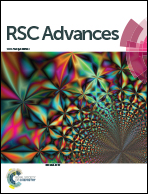Synthesis and studies of electrochemical properties of lophine derivatives†
Abstract
A versatile series of lophine (2,4,5-triphenyl-1H-imidazole) derivatives (1–13) were synthesized and characterized using melting point investigation, Fourier transform infrared spectroscopy (FTIR), Liquid Chromatography-Mass Spectrometry (LC-MS), and 1H and 13C nuclear magnetic resonance (NMR) spectroscopy. Their photo physical and electrochemical parameters were evaluated using Ultraviolet-visible (UV-Vis) spectroscopy, fluorescence spectrophotometry and cyclic voltammetric experiments. The optical band gap and quantum yield for the derivatives were in the range of 3.05–3.55 eV and 0.06 to 0.36, respectively. The HUMO–LUMO and associated energy gaps (Eg) calculated through the cyclic voltammetric experiments were found to be in the range of 0.068–0.194 eV. Among them, the derivatives with electron donating groups such as N(Me)2, phenyl and methoxy more efficiently facilitated the redox process as compared to lophine. N(Me)2 was found to be more effective because of the enhancement of electron density on nitrogen because of the electron donating ability of the two methyl groups.


 Please wait while we load your content...
Please wait while we load your content...